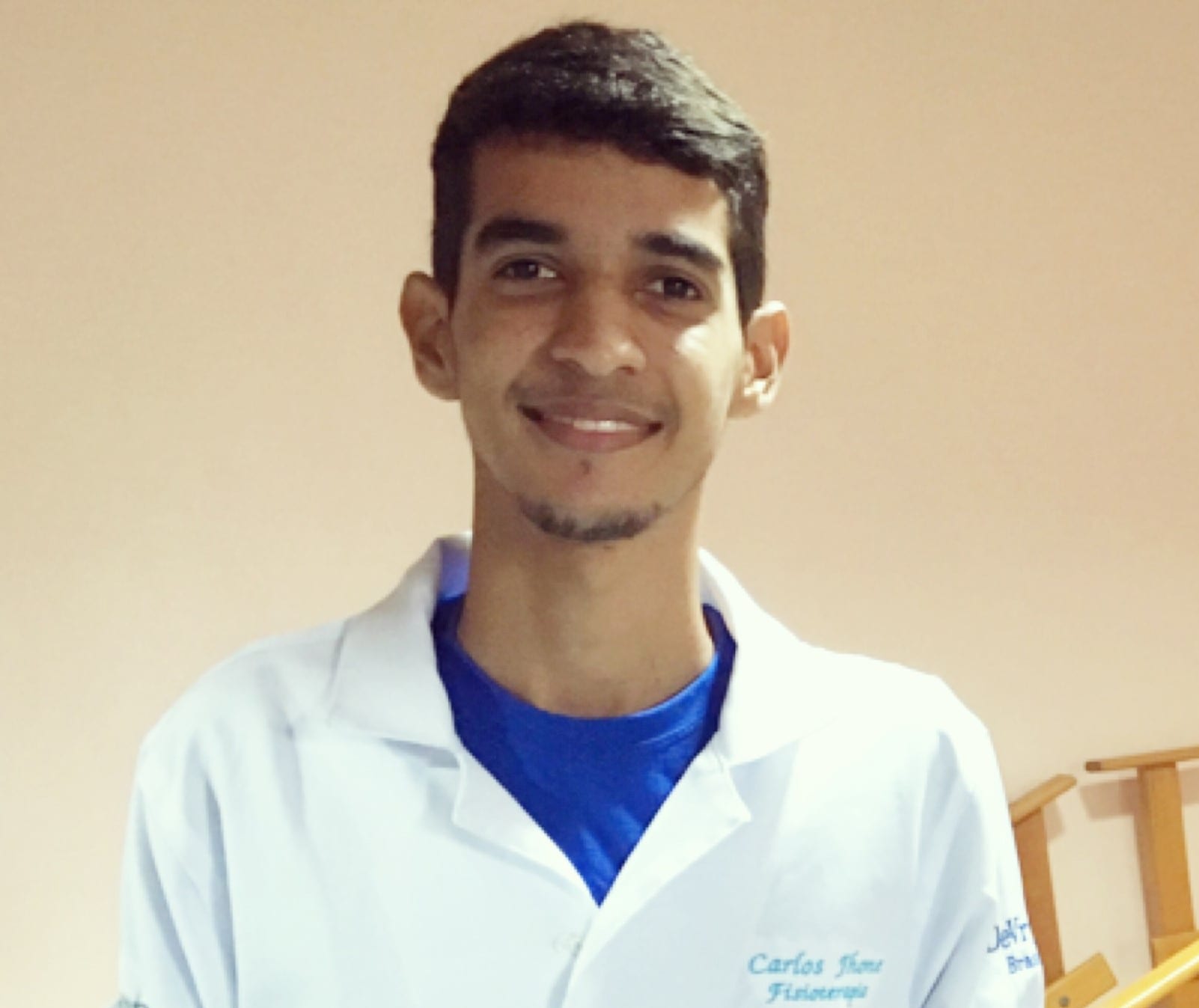COELHO, Carlos Jhone [1]
COELHO, Carlos Jhone. Effectiveness of Hidroterapeutica Assistance in the patient after surgery of Anterior Cruciate Ligament. Multidisciplinary Core scientific journal of knowledge. 03 year, Ed. 07, vol. 01, pp. 142-150, July 2018. ISSN:2448-0959
Summary
The Anterior Cruciate Ligament is one of the major ligaments of the knee and what else suffers injury in practitioners of physical activities. Hydrotherapy is a feature of physiotherapy in rehabilitation functional changes. Within those concepts, the study aims to assess the effects of this therapy in the rehabilitation of patients with injury of ligament, from the range of motion, strength and Perimetry. This is a case report, conducted in a clinical school to an institution of higher education in the city of Fortaleza, CE, during the period from August to November 2016. The patient came presenting grade 4 to grade 3 for flexion and extension in muscular strength test, with 50° to 60° for flexion and extension in goniometry. In perimetry, presented 44 cm 5 cm above the top edge of the patella. The patient was served twice a week, in the period of 30 minutes each. Marching exercises was carried out front and side, Hidrocinesioterapia exercises, as well as proprioceptive training. At the end of the therapy, the revaluation was carried out, where they were shown significant improvement. In range of motion, was won 30° and 40° flexion in knee extension injured. In tests of muscle strength, gaining 3 points to 4 points and flexion 4:00 pm to 5:00 pm extension, according to the scale of Oxford. One can also observe the decrease of edema, which went from 46 cm to 42 cm, evaluating by perimetry. The treatment showed that hydrotherapy can be a tool of great contribution to the rehabilitation of these patients.
Key words: injury, Anterior Cruciate Ligament, hydrotherapy.
Introduction
The knee is an intermediate articulation of the lower limb and is considered unstable bone's point of view. As the ligament and muscular system are its main stabilizers the knee is quite susceptible to traumatic injuries, and is always subject to efforts already located between an arm and a lever arm, the tibia and the femur, besides not being protected by fatty tissue and muscle tissue. The little anatomical protection contributes to the high incidence of injuries in this joint. ¹
The Anterior Cruciate Ligament (ACL) is one of the major ligaments of the knee and what else suffers injury in practitioners of physical activities. Has the main function to maintain the stability of the knee and is usually injured when suffers a torsional strength, causing a breakup. ¹
This injury is related primarily to sports that require change of direction and movements of rotation, which exposes the joint to situations of greater vulnerability. ²
ACL injuries occur more frequently in young sportsmen, especially in males. The biomechanical mechanism of trauma often hyperextension with stress, forcing the lateral rotation of the tibia, being the fixed foot. ³
Hydrotherapy is a feature of physiotherapy, rehabilitation on functional changes, having as the physical effects, physiological and cinesiológicos. In the rehabilitation of this injury, specifically, what is needed is the gain range of motion, muscle strength, balance gain, besides the reduction in pain and swelling.
The aquatic physiotherapy aims to promote maximum functional independence possible, minimizing the abnormal responses and potentializing the movements are suitable, taking advantage of physical and thermodynamic principles of water. Among these principles is the thrust, the opposing force of gravity acting on the object immersed, which provides buoyancy; the hydrostatic pressure, pressure the water exerts on the body in all directions; and viscosity, attraction between water molecules creates a resistance to movement, contributing in this way to the muscle-building. 4
On these concepts and the case accompanied, the rationale for this study is the curiosity of the authors to examine the effects of Aquatic Therapy brought to the patient in post-op of LCA, after the calls, showing the main malfunctions: range of motion, strength and Perimetry. Being as an incentive to other students for further studies and interventions.
Materials and methods
This study this is a case report, conducted in a clinical school to an institution of higher education in the city of Fortaleza, CE, during the period from August to November 2016, during the activities of discipline practice of Hydrotherapy of the undergraduate program In physiotherapy. The patient surgical post ACL reconstruction, arrived to the sector of Physiotherapy, and was subjected to a general assessment, industry-specific, hydrotherapy being watched mainly Articular range of motion, muscle strength and Knee Injured perimetry. The study observed all rules contained in resolution 466/12 of the Ministry of health, with regard to bioethical aspects of humans. The patient signed an informed consent, where reported that your identity would be preserved in the disclosure of your data.
Case report
P.S.B.C.J., 36 years old patient, male, sport, Jiu Jitsu teacher, diagnosed with complete disruption of LCA. The injury occurred during one of the competitions, where the opponent held an unexpected blow on his right leg, in the lateral direction. Surgery for ligament reconstruction was carried out 2 months after the fact, starting 2 weeks after rehabilitation. The patient came presenting grade 4 to grade 3 for flexion and extension in muscular strength test, with 50° to 60° for flexion and extension in goniometry. In perimetry, presented 44 cm 5 cm above the top edge of the patella.
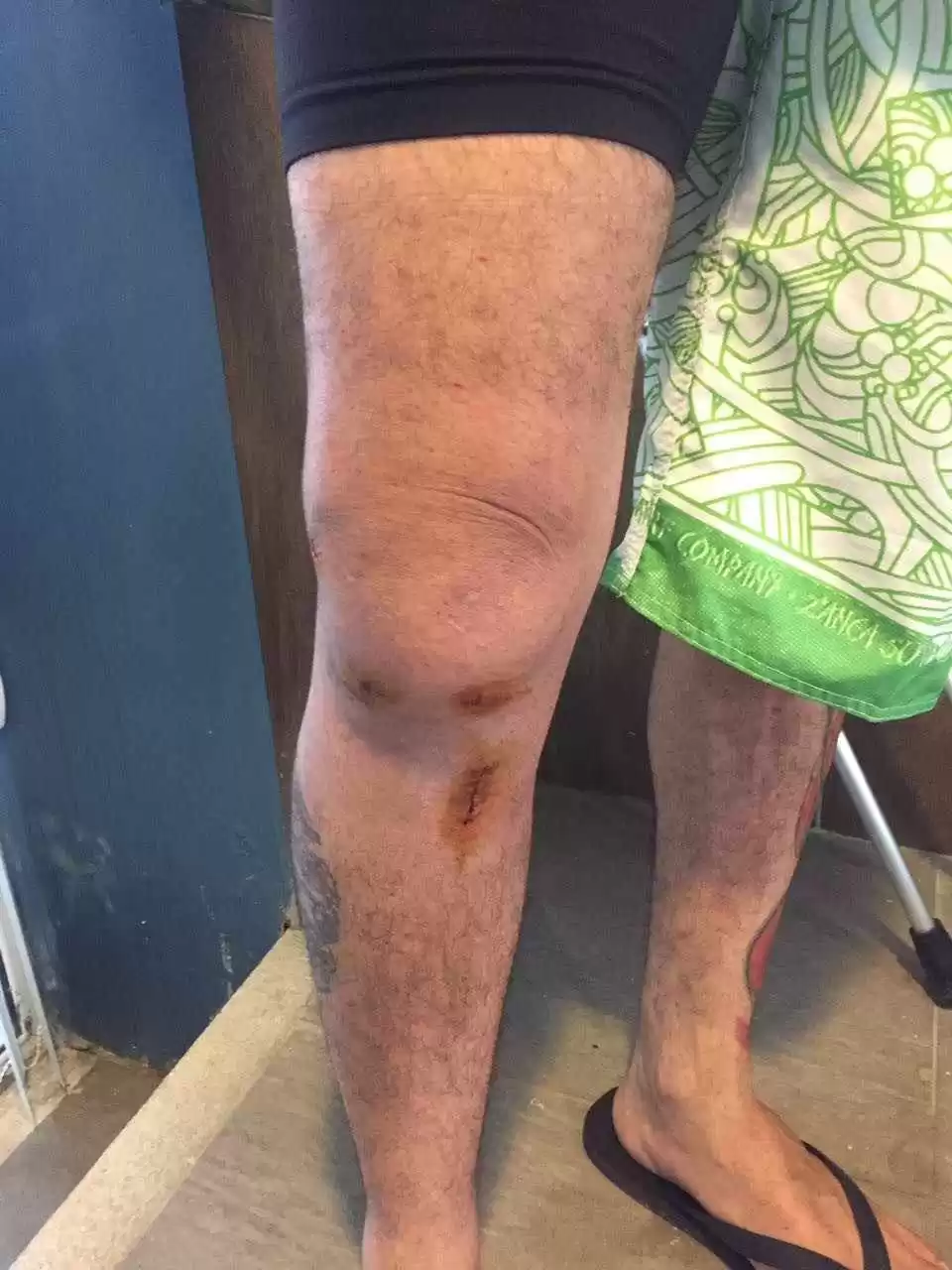
Conduct physiotherapist
The patient was served twice a week in the pool, in the period of 30 minutes each. Was held, first, mobilizations and passive exercises, in order to reduce possible complications, as well as muscle stiffness and hypotrophy. Soon after the first calls, marching exercises were carried out front and side, Hidrocinesioterapia exercises, such as stretching and Strengthening of the muscles of the anterior and posterior chain, with the use of floats long, leggings and accessories that allow patient resistance as well as proprioceptive training.
Results and discussion
The knee along with the entire lower limb exercises an important role in human locomotion during their daily life activities and in spite of all cargo that must support, the knee joint is relatively weak biomechanical point of view, due to settings of your joint surfaces, getting your resistance in dependence of the ligaments that attach the femur to the tibia, the anterior cruciate ligament which is the primary stabilizer of the knee. 5
It is known that with the ACL rupture occurs the knee joint instability causing limitations in daily life activities and sport of the affected individuals. 6 due to specific features of the injury, the rehabilitation of amplitude gain search motion, improves muscle strength, balance gain, besides the reduction in pain and swelling.
After the therapy, a re-evaluation was performed for the comparison of the findings. The patient presented significant improvements as range of motion, where was won 30° and 40° flexion in knee extension injured, measured with a goniometer. When reevaluated the muscular force, earning 3 points to 4 points and flexion 4:00 pm to 5:00 pm extension, commensurate with the scale of Oxford. One can also observe the decrease of edema, which went from 46 cm to 42 cm, evaluating by perimetry.
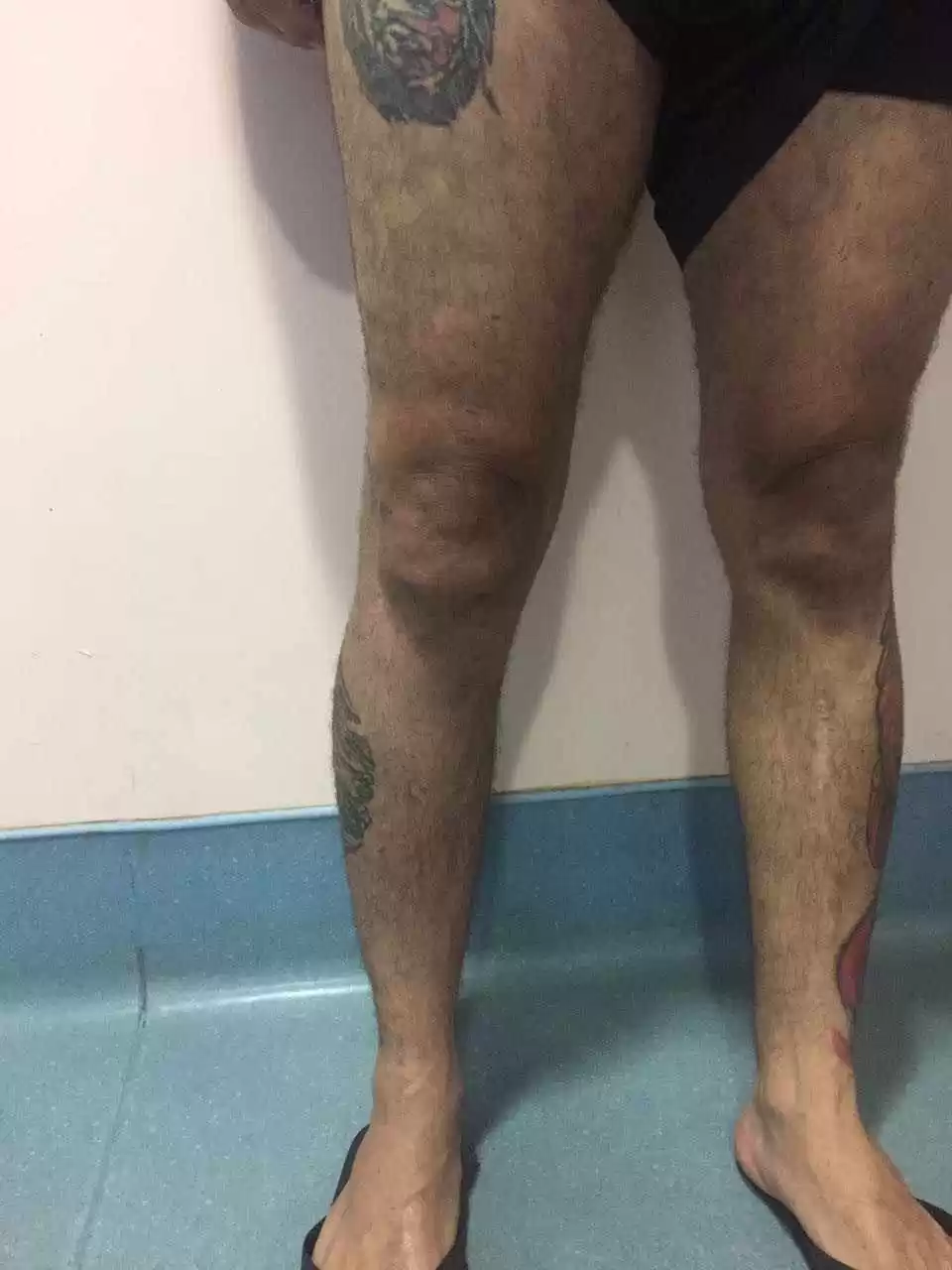
The findings were expressed in the form of graphics for better understanding:
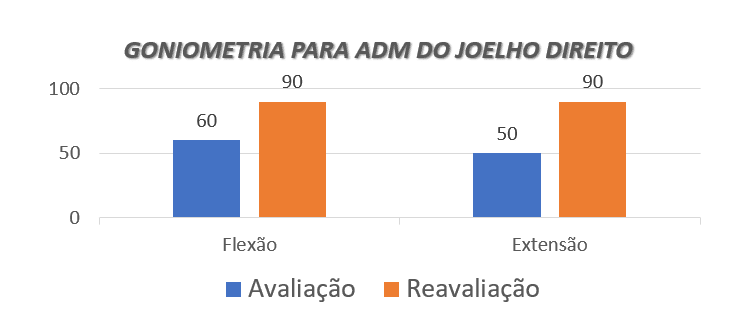
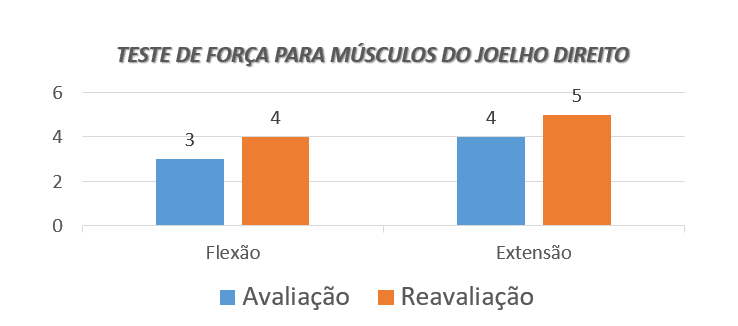
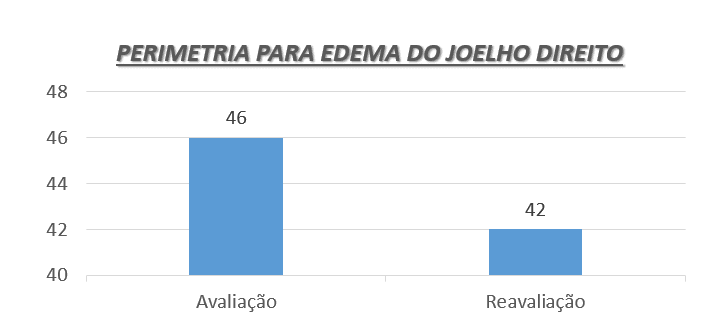
Hydrotherapy compared to other techniques have been shown to be more beneficial, because it is an approach that can be used even when there is pain, inflammation, retraction, muscle spasm, limitation of WMD and to provide a controlled environment and suitable for restoration of the functional skills. 7
Currently the proprioceptive training, electrotherapy, cryotherapy, resistance training and closed kinetic chain exercises are the main therapeutic modalities specifically employed .8 However the aquatic exercises if highlight the ability to allow early active mobilization and develop a neuromuscular performance, especially during acute phase. 9
Hydrotherapy is an excellent resource on rehabilitation of ACL injury, because of the physical properties and water warming, playing an important role in improving and maintaining range of motion of the joints, reduction of muscle tension and the relaxation.
The decrease in joint impact during physical activities, induced by flotation, reducing sensitivity to pain, reduced joint compression, provides greater freedom of movement and decreases the spasm. The effects of buoyancy aid the movement of stiffened joints in larger amplitudes with minimum pain sensation. The strengthening exercises with submerged patient are based on physical principles of hydrostatic pressure, which allow you to generate resistance constant movements. multidimensional 10
The advantage of performing aquatic exercises in relation to the Earth is that, besides being possible to achieve benefits in the different components of the physical fitness, the liquid medium provides low impact in the lower limbs and greater or lesser overload arrived today, according to the movements performed, and may also be employed as a therapeutic resource on acute phase. 11
Conclusion
The treatment showed that hydrotherapy can be a tool of great contribution to the rehabilitation of these patients, as it provides a load less aggressive rehabilitation, showing gains and providing early return functions everyday. However new studies can and should be held to contribute even more in the elucidation of this theme.
References
1Sá MC, Sharma ALV. Hydrotherapy post-op anterior cruciate ligament (ACL). Multidisciplinary Journal of Northeast. 2010; 2 (1): 20-3;
2Marchetti PH, Bucchianico EG, Amore T, Nardi PSM, Gali JC, Uchida MC. Performance of lower limbs after anterior cruciate ligament reconstruction. Rev engine. Educ. fís. 2012; 18 (3): 441-8;
3Kisner C, Colby LA. Therapeutic exercise: foundations and techniques. 4th ed. São Paulo: Manole; 2005;
4Meneghetti CHZ, Basqueira C, Fioramonte C, Junior LCF. Influence of aquatic physiotherapy in trunk control on Pusher syndrome: a case study. Fisioter. Search. 2009; 16 (3): 269-73;
5Cailliet r. knee pain. 3rd ed. Porto Alegre: New Haven; 2001;
6Pizzato LM, Arakaki JC, Vasconcelos RA, Sposito GC, Oliveira, Paccola C, et al. Analysis of the median frequency of the electromyographic signal of individuals with damage to the anterior cruciate ligament in isometric exercises of open and closed kinetic chain. Rev. Bras. Med. Sport. 2007; 13 (1): 1-5;
7Kouri j. aquatic physiotherapy programme: a guide to the Orthopedic rehabilitation. São Paulo: Manole; 2000;
8Júnior SS, RG, Gonçalves Coast SM, Paizante GO. Physiotherapeutic treatment after anterior cruciate ligament reconstruction using patellar tendon graft[trabalho de conclusão de curso]. Governador Valadares: Universidade Vale do Rio Doce (UNIVALE); 2009;
9Cattelan AV, Banu AK, AD Petrochi. Aquatic physiotherapy in anterior cruciate ligament reconstruction: case report. Digital Magazine Buenos Aires. 2009; 14 (131): 1-1;
10Candeloro JM, Caromano FA. Effect of a hydrotherapy program flexibility and muscle strength in elderly people. Braz j phys. ther. 2007; 11 (4): 303-9;
11Alberton CL, Kruel LFM. Influence of immersion in cardiorespiratory responses at rest. Rev. Bras. Med. Sport. 2007; 15 (3): 228-32.
[1] Scholar, trainee, and monitor researcher course of physiotherapy-Northeast College-DeVry Fanor
